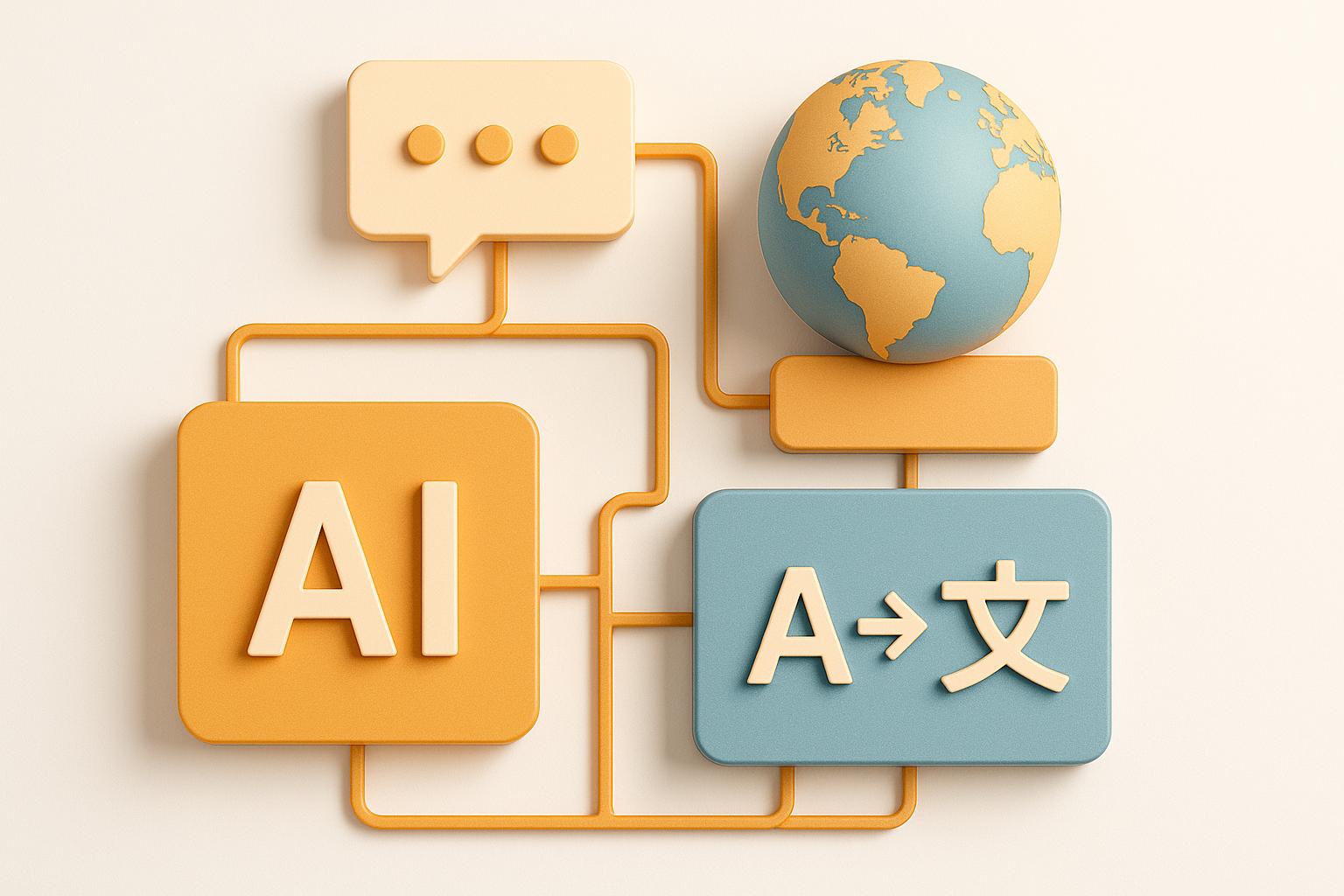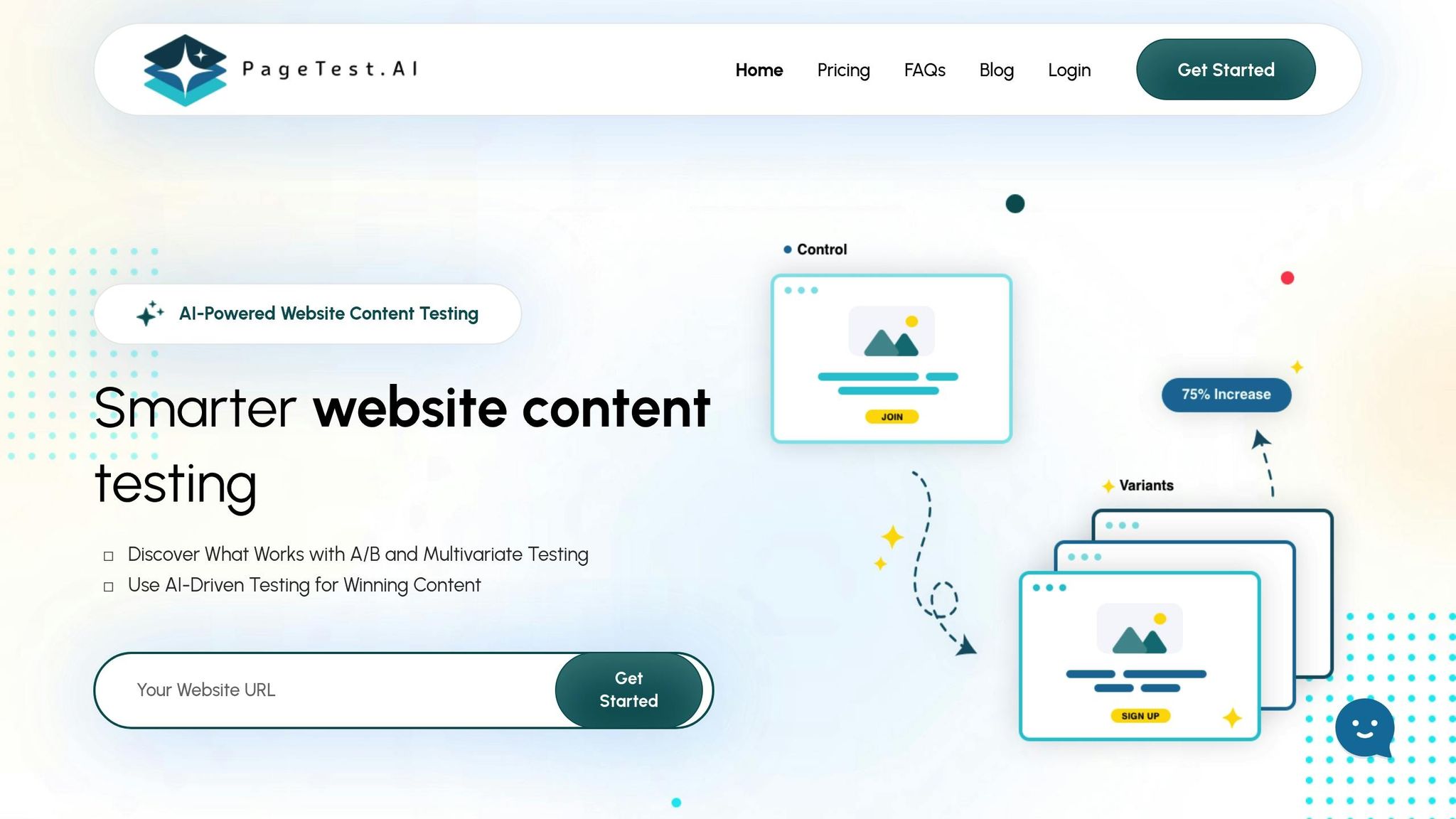

How AI Improves Multilingual QA

How AI Improves Multilingual QA
 04-11-2025 (Last modified: 04-11-2025)
04-11-2025 (Last modified: 04-11-2025)
AI-powered multilingual quality assurance (QA) helps businesses ensure translations are accurate, consistent, and meet local standards. By automating error detection, offering real-time feedback, and validating content for regional norms, AI significantly reduces manual review time and improves efficiency. Here’s what you need to know:
- Faster QA: AI tools process translations in hours instead of weeks, cutting review time by up to 50%.
- Error Detection: Natural language processing (NLP) identifies spelling, grammar, and terminology issues.
- Consistency: Translation memory systems flag inconsistencies, maintaining uniformity across documents.
- Localized Validation: AI ensures content adheres to U.S. standards, like date formats (MM/DD/YYYY) and currency ($).
- Cost Savings: Automation reduces labor costs by 30–60% while improving accuracy.
AI tools like PageTest.AI, Smartcat, and Phrase make QA more efficient by combining automation with human oversight. This hybrid approach ensures high-quality translations that align with business goals and local requirements.
Main Steps in AI-Powered Multilingual QA
AI simplifies the process of multilingual quality assurance (QA) by combining automation with intelligent validation. This structured approach helps identify errors, maintain consistency, and ensure content aligns with local standards – crucial for businesses looking to expand globally.
Automated Error Detection and Correction
At the heart of modern multilingual QA is AI-driven error detection. Using natural language processing (NLP), these tools scan content across multiple languages, spotting spelling mistakes, grammar issues, formatting inconsistencies, and terminology errors simultaneously.
The system operates on several levels. Basic checks identify obvious mistakes, while deeper semantic analysis ensures the original meaning remains intact. AI even categorizes errors by severity, making it easier to prioritize and address critical issues.
One standout feature is terminology validation. AI flags inconsistent usage of brand names, product terms, or technical jargon across translations. For instance, if a software manual uses different translations for “login” in the same language, the system highlights this inconsistency for correction.
By integrating with translation memory systems, AI tools also ensure recurring phrases are translated uniformly, further boosting consistency. Overall, these AI-powered QA tools can cut manual review time by as much as 50%.
Real-Time Translation and Feedback
Real-time feedback shifts QA from a post-translation task to an integrated part of the workflow. With instant assessments of translation quality, style, and potential issues, AI tools provide actionable feedback as translations are created.
Algorithms evaluate translations for accuracy, fluency, consistency, and adherence to style guidelines, flagging issues and offering quick fixes. When combined with translation management systems, these tools automate quality checks at multiple stages, catching problems early when they’re easier and cheaper to resolve.
This real-time approach also enhances collaboration among translators, ensuring consistent feedback and suggestions across the team. Moreover, AI ensures that translations meet U.S.-specific standards through focused local validation, making the process even more precise.
Local and Contextual Validation
Local validation ensures translations align with U.S. standards and cultural norms. AI tools check for proper formatting – like dates in the MM/DD/YYYY format, dollar signs for currency, and imperial units for measurements.
Beyond formatting, AI evaluates cultural appropriateness and regional relevance. For example, it can suggest converting metric measurements to imperial units or adjusting messaging to better resonate with American audiences.
These tools also verify that content like product descriptions, marketing copy, and user interface elements follow U.S. conventions for tone, style, and presentation. This includes using American English spelling (e.g., “optimize” instead of “optimise”) and correctly formatting prices with dollar signs and decimal points.
Finally, contextual analysis ensures translations are tailored to their target audience – whether they’re consumers, business professionals, or technical users. This guarantees that translations are both linguistically accurate and culturally appropriate, supporting business goals while maintaining high-quality communication.
Key Benefits of AI in Multilingual QA
AI-powered multilingual quality assurance (QA) has become a game-changer for U.S. businesses, offering measurable improvements in efficiency, accuracy, and cost management. By integrating automated detection, real-time feedback, and localized validation, AI simplifies the complexities of managing multilingual content.
Improved Speed and Accuracy
AI dramatically speeds up multilingual QA processes while maintaining high levels of precision. Unlike traditional manual reviews, which can take days or even weeks for large projects, AI tools can process and validate hundreds of thousands of words per hour – far beyond human capabilities.
For example, AI-powered QA tools have been shown to cut review times by up to 50% compared to manual processes. This speed is especially useful for time-sensitive campaigns or product launches that need to roll out across multiple markets simultaneously. A global e-commerce company, for instance, used AI tools to review product descriptions in various languages, reducing review time by 60% and cutting translation errors by 30%.
Another advantage is AI’s ability to maintain focus and consistency over long periods. Unlike human reviewers, who may become fatigued or lose focus after extended hours of work, AI consistently identifies subtle inconsistencies in style and tone. This reliability is crucial for preserving a unified brand voice across multiple languages.
Better Consistency and Scalability
Beyond speed and accuracy, AI ensures consistent quality across all content, no matter the language or volume. This consistency addresses one of the most significant challenges in multilingual content management: maintaining uniform quality standards. By leveraging tools like translation memory and natural language processing (NLP), AI enforces a cohesive brand voice and scales effortlessly during periods of high demand.
AI tools are particularly adept at analyzing and applying brand-specific tone and style guidelines. They can even identify culturally sensitive content and suggest localized alternatives, ensuring messaging resonates appropriately with diverse audiences in the U.S. and abroad.
Scalability is another standout feature. During peak seasons or major product launches, manual QA teams often struggle to manage sudden spikes in workload, requiring additional staffing. In contrast, AI systems adapt seamlessly to increased demands without sacrificing quality or turnaround times.
Cost Savings Through Automation
By automating repetitive QA tasks, AI significantly reduces labor costs and operational expenses. Companies using AI for translation QA report cost savings of 30–60% in their localization workflows. These savings stem from reduced reliance on manual reviews, smaller quality control teams, and faster project completion times.
For businesses, this means more than just cutting costs. Automating routine QA tasks frees up human experts to focus on more complex localization challenges and strategic initiatives, such as market expansion. This smarter use of resources allows companies to maintain high-quality standards across multiple languages without proportional increases in expenses.
The financial benefits extend beyond direct savings. Faster time-to-market, improved customer satisfaction, and minimized risk of costly translation errors all contribute to a stronger return on investment. For U.S. businesses, these advantages make it easier to expand into new markets while keeping localization efforts both efficient and affordable. AI-powered QA ensures businesses can confidently grow their global presence while maintaining control over costs.
Top AI Tools for Multilingual QA
When it comes to leveraging the speed, reliability, and cost-effectiveness of AI-powered QA, selecting the right tool is key to ensuring smooth and efficient workflows. The market offers a variety of specialized platforms, each tailored to managing and testing multilingual website content. Here’s a closer look at some of the top AI tools designed to streamline multilingual QA processes.
PageTest.AI for Multilingual Content Testing

PageTest.AI is an all-in-one solution for testing and optimizing multilingual website content. It focuses on A/B and multivariate testing, helping businesses compare different versions of their content across languages to determine which resonates best with specific audiences.
What makes PageTest.AI stand out is its no-code setup. Using a Chrome extension, teams can easily select website elements – like headlines, call-to-action buttons, product descriptions, or entire sections – and instantly create AI-powered content variations. This eliminates technical barriers and speeds up the testing process.
The tool tracks key performance metrics, including clicks, engagement, time spent on a page, and scroll depth. For multilingual content, it enables businesses to compare how their Spanish, Chinese, or French versions perform compared to English, empowering them to make data-driven decisions for optimization.
“Love this product, it means we get the most from our site’s traffic. Knowing we can test every call to action and optimize our SEO efforts is very satisfying.” – David Hall, CEO | AppInstitute
PageTest.AI integrates seamlessly with popular platforms like WordPress, Shopify, Wix, and Google Tag Manager. Its pricing is flexible, starting with a free trial (10,000 test impressions included), and ranges from $10/month for startups to $200/month for agencies managing multiple websites.
Other Notable Tools
In addition to PageTest.AI, there are other tools that shine in specific areas of multilingual QA:
- Smartcat: Designed for collaborative translation, Smartcat offers built-in quality assurance features. Its in-editor QA suggestions catch grammar errors, consistency issues, and terminology mismatches in real time, making it especially useful for teams handling large translation projects.
- Phrase: This platform integrates AI-driven quality checks directly into its translation management system. Features like smart tagging and automated validation ensure consistent terminology and adherence to brand standards throughout the localization process.
Both Smartcat and Phrase offer robust API access and seamless integration with existing CAT (computer-assisted translation) and TMS (translation management system) platforms, making them ideal for enterprises with established localization workflows.
Feature Comparison Table
| Tool | Key Features | Integration Options | Pricing (USD) |
|---|---|---|---|
| PageTest.AI | AI content variations, A/B & multivariate testing, performance tracking, no-code setup | Website builders, APIs, Chrome extension | $0–$200/month (Free trial) |
| Smartcat | In-editor QA suggestions, glossary checks, collaborative translation, real-time feedback | CAT/TMS platforms, APIs | Free / $79+/month |
| Phrase | Embedded QA, terminology validation, smart tagging, workflow automation | TMS, APIs | $50+/month |
Choosing the Right Tool
The best tool for your needs depends on your specific workflow. PageTest.AI is ideal for optimizing multilingual website performance, while Smartcat excels in collaborative translation, and Phrase integrates QA directly into translation workflows.
For U.S.-based businesses expanding globally, handling localization for American conventions – like dollar signs, MM/DD/YYYY dates, and imperial measurements – is essential. All three platforms support these requirements, ensuring multilingual content aligns with U.S. standards while effectively engaging international audiences. By strategically implementing these tools, you can elevate your multilingual QA efforts and achieve better results.
sbb-itb-6e49fcd
Best Practices for Implementing AI in Multilingual QA
Implementing AI in multilingual quality assurance (QA) calls for a thoughtful approach that blends automation with human expertise. The goal is to leverage AI where it shines while relying on human judgment for areas that require a nuanced understanding.
Training AI Models for U.S. Standards
For multilingual QA to succeed, start by training your AI models with high-quality, U.S.-specific data. This ensures the AI understands American English conventions – like spelling differences (“color” vs. “colour”) and cultural references that resonate with U.S. audiences.
The key is to curate training datasets from trusted U.S. sources, such as reputable publications, legal documents, and customer communications. This helps the AI learn proper formatting, like MM/DD/YYYY for dates, $1,000.00 for currency, and imperial units such as miles, pounds, and Fahrenheit temperatures.
Regional terminology is equally important. Your AI should recognize U.S.-specific terms, product names, and idiomatic expressions. For instance, Americans say “elevator” instead of “lift” or “apartment” rather than “flat.” Including these distinctions in the training process ensures translations feel natural and relatable to U.S. users.
Regulatory compliance is another essential focus. U.S. businesses must adhere to specific legal disclaimers, healthcare regulations, and industry standards. Training your AI with examples of compliant language ensures automated QA can flag potential regulatory issues before content goes live.
Keep your AI updated with input from U.S.-based QA teams to align with evolving language trends and regulatory changes. When well-trained, AI can work seamlessly alongside human reviewers to create a balanced, efficient QA process.
Combining Automation with Human Oversight
Once your AI is trained for U.S. standards, integrating human oversight ensures a well-rounded QA process. AI is highly effective at identifying grammar errors, consistency issues, and terminology mismatches across large datasets. However, human reviewers are still essential for evaluating context, tone, and cultural sensitivity.
For example, a U.S. e-commerce company successfully used AI-powered QA tools to review product descriptions in both English and Spanish. AI handled the initial checks, while human reviewers provided final approvals. This hybrid approach reduced translation errors by 40%, sped up product launches, and ensured compliance with U.S. labeling regulations.
Establish clear escalation protocols for content that requires human review. Documents like legal contracts, healthcare information, emotionally driven marketing campaigns, and HR policies should always receive a human touch after AI screening. Regular calibration sessions between AI outputs and human reviewers can also help refine the models and address recurring issues.
Consider a hybrid workflow where AI tackles repetitive error detection at scale, while human experts focus on high-risk or sensitive content. This division of labor boosts efficiency and ensures high-quality results, meeting the dual goals of speed and accuracy while maintaining U.S. standards.
Tracking Performance Metrics with AI Tools
Once a hybrid QA workflow is in place, tracking performance metrics becomes essential for continuous improvement. Many modern AI tools offer analytics that help assess quality and measure the business impact of multilingual content.
Monitor error rates by content type and language pair. Analyzing how often AI catches errors versus those flagged by human reviewers can highlight areas where the AI needs further refinement.
Engagement metrics, such as time on page and scroll depth, also provide insights into content quality. For instance, if Spanish-language content consistently shows lower engagement than English, it may indicate translation issues that need attention.
Additionally, track turnaround times for AI-assisted versus manual QA processes to identify workflow bottlenecks. Customer satisfaction scores and conversion rates by language version can reveal how QA quality impacts user engagement and business outcomes.
Regularly reviewing these metrics ensures your QA process continues to deliver value. By understanding both quality and business performance, you can fine-tune your AI training and human oversight strategies to meet the high expectations of U.S. customers. This data-driven approach not only reinforces quality assurance but also helps optimize workflows for better results.
Conclusion
AI has reshaped how multilingual quality assurance is handled, bringing the speed, accuracy, and consistency that U.S. businesses need to stay competitive on a global stage. Tasks that once demanded hours of manual effort, like error detection and correction, are now automated, saving time and resources.
This shift has had a measurable impact on business operations. Companies are experiencing faster product launches, reduced costs, and improved risk management. For businesses operating in diverse markets, where precision and local relevance are crucial, these advancements provide a clear competitive edge. Accuracy and alignment with local expectations directly influence customer trust and, ultimately, conversion rates.
AI tools also ensure that brand voice and messaging remain consistent across languages while adhering to U.S. standards, such as date formats (MM/DD/YYYY), currency ($1,000.00), and imperial measurements. Achieving this level of precision and attention to local details previously required intensive human review. Today, these tools set the foundation for the next generation of multilingual QA solutions.
Take, for instance, PageTest.AI – a no-code platform designed for A/B and multivariate testing of website content. This tool uses AI to generate content variations and measure performance metrics like clicks and engagement. U.S. businesses can use it to refine multilingual headlines, CTAs, and product descriptions, tailoring them for their target audiences with ease.
The key to success lies in blending AI capabilities with human expertise. Automated tools handle the heavy lifting, but human oversight ensures the nuanced quality needed for long-term customer relationships. By striking this balance, businesses can meet the fast-paced demands of global markets while maintaining the high standards their customers expect.
FAQs
How does AI ensure multilingual content aligns with cultural and regional standards?
AI-driven multilingual quality assurance (QA) takes translations to the next level by examining more than just linguistic accuracy. These advanced tools delve into context, tone, and regional preferences to ensure the content feels natural and relatable to the target audience.
By spotting potential cultural missteps and fine-tuning the phrasing, AI helps make translations both precise and culturally sensitive. This approach allows businesses to communicate effectively with audiences from diverse backgrounds, fostering stronger connections across regions.
How does human oversight enhance AI-driven multilingual quality assurance?
Human oversight is key to ensuring both the accuracy and the cultural appropriateness of AI-powered multilingual quality assurance. While AI is great at automating translations, spotting errors, and keeping language consistent, it often misses subtle language details like idiomatic expressions or cultural nuances. That’s where human expertise steps in.
By blending AI’s speed with human judgment, businesses can create multilingual content that not only meets technical standards but also connects with diverse audiences and stays true to their brand voice. This partnership brings both efficiency and precision to the quality assurance process.
How can businesses seamlessly integrate AI into their translation and localization processes?
When integrating AI into translation and localization workflows, tools like PageTest.AI can make a big difference. This platform offers a no-code solution that simplifies content optimization, letting businesses test and fine-tune elements like headlines, calls-to-action (CTAs), and product descriptions with ease.
By creating AI-generated content variations and analyzing metrics such as user engagement and click behavior, companies can ensure their multilingual content connects with a wide range of audiences. This method not only improves the quality of the content but also saves time and effort through automation.
Related Blog Posts
say hello to easy Content Testing
try PageTest.AI tool for free
Start making the most of your websites traffic and optimize your content and CTAs.
Related Posts

 03-11-2025
03-11-2025
 Ian Naylor
Ian Naylor
How Real-Time Alerts Improve Conversion Rates
Real-time alerts empower businesses to quickly detect and resolve issues, enhancing user experience and driving higher conversion rates.

 01-11-2025
01-11-2025
 Ian Naylor
Ian Naylor
Ultimate Guide to Third-Party Script Monitoring
Learn how to monitor and manage third-party scripts for improved website performance, security, and compliance with essential best practices.

 30-10-2025
30-10-2025
 Ian Naylor
Ian Naylor
Scroll Maps for UX and CRO
Explore how scroll maps enhance user experience and boost conversions by revealing user behavior on your website.
